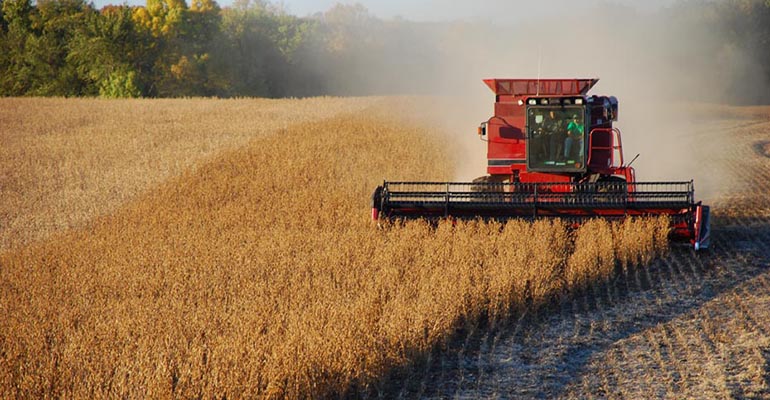August 1, 2010

In late June, Mark Sandage was striving to get replanted soybeans up and running, knowing they would likely be late maturing for harvest. That meant he was already facing a possible fall bottleneck that could put pressure on harvest-ready beans containing too much foliage.
Luckily, he has experience using harvest aids to kill excessive greenery and combine-clogging weeds.
The Keo, AR, corn, bean and rice grower faced a similar situation in recent years and managed to speed up harvest by a week to 10 days on some fields. He and his brother Kevin and father Bill were a little too far south to benefit from a hard enough freeze to count on Mother Nature to do the killing.
“The plants were really green when the beans were ready to harvest,” says Sandage. “The harvest-aid treatments helped us out. I prefer not to spend money to get something ready for harvest, but sometimes it’s needed.”
Adds Bob Scott, University of Arkansas weed specialist, “There’s someone using harvest aids every year. And this could be a year that more growers require them, even though we could be late enough that a freeze actually helps out a lot.”
Harvest aids have been more common in cotton production across the Mississippi Delta and other growing areas. But with more acres now in soybeans, there is greater pressure to have beans ready for harvest at a time when corn also needs cutting.
Mixes of Gramoxone (paraquat) and sodium chlorate or Aim are common herbicides used to kill soybean foliage. But Sandage stresses that the harvest aids aren’t part of his family’s normal growth-management program.
“We normally plant Group 5 beans but had a situation where we had some Group 4s,” he says. “They weren’t mature enough to harvest. We had to use the harvest-aid program in that particular situation.”
It was late October and a tankmix of Gramoxone and Aim was applied by an aerial applicator. The procedure worked, but the crop yielded below what the Group 5s would normally produce.
“It wasn’t because of the harvest aid program that yields were down,” says Sandage, “but the strong pressure on the plants that required it.”
Don’t count on a harvest aid to dry down grain. “There isn’t much data showing that harvest aids lower the moisture content of grain or soybeans,” says Scott. “Unlike boll openers and defoliants in cotton, harvest aids do little to speed the crop along.”
He says that the purpose of most harvest-aid applications is to decrease the amount of green material that runs through the combine. Weed-control failures in good growing conditions and favorable moisture that has delayed the natural desiccation of weeds and crop foliage can create the need for them.
“Gramoxone is labeled as a harvest aid in soybeans at 1 pt./acre,” says Scott. “This treatment should be applied only after half the soybean leaves have dropped and the other half are yellow.
“This also applies to sodium chlorate in soybeans. I often recommend a combination of sodium chlorate plus paraquat for really grown-up fields. You can substitute Aim with sodium chlorate if morning glories are a primary concern,” Scott says.
He notes that sodium chlorate is labeled for corn, grain sorghum, soybeans and rice at up to 6 lbs./acre, or 2 gal. of a 3-lb./gal. formula or 1 gal. of a 6-lb./gal. formula.
“This treatment should go out about five days prior to harvest when grain is below 25% moisture,” says Scott, stressing that harvest aids can increase combine efficiency and improve the quality of harvested beans and grain.
“They can get you in the field sooner by eliminating green leaves and weed material. However, grain moisture should be monitored and harvest aids applied only when you are the proper number of days out from harvest.”
He warns growers not to shorten this interval thinking the grain will dry down following a harvest-aid application. “Applying harvest aids too soon may result in the crop lodging or failing to mature correctly,” says Scott.
He points out that glyphosate is usually “not the best harvest aid, although it does have labeling for that use in many crops. It usually takes between 10 and 14 days for glyphosate to work – a long time in the harvest-aid market where treatments often go out only a few days prior to harvest.”
University of Missouri (UM) studies from the 1990s show that excessive weeds and plant greenery can slow the speed of harvest, cause combine problems and excessive combining losses, cause elevator docking for quality or create soybean storage problems.
Kevin Bradley, UM weed scientist, says research by former UM agronomists L.E. Anderson and Z.R. Helsel shows various rates of harvest loss due to weed infestations. For example, approximately two pigweeds per foot of 30-in. row resulted in about a 7% harvest loss at 2-3-mph combine speed.
Also, about 2.5 foxtail plants per foot resulted in a 3-4% loss. Some weeds, such as drought-stressed cockleburs and others, are not affected much by crop desiccants. “Weeds with juicy berries, such as black nightshade, may be killed by desiccants, but the berries may still cause problems with combine operation,” the UM studies indicate.
The studies show that soybeans that will be mature enough to harvest within a week of the expected date of the first hard frost probably wouldn’t benefit from weed desiccation. However, beans that will mature more than two weeks before the average date of the first frost may benefit from a harvest-aid program if weeds are a problem.
As for what Sandage expects to see this year in the need for harvest aids, he can’t be sure. “We like to begin bean harvest by Oct. 10 and finish by the first week in November,” he says. “But since we were three weeks behind, we could be cutting all through November.”
August 2010
About the Author(s)
You May Also Like




